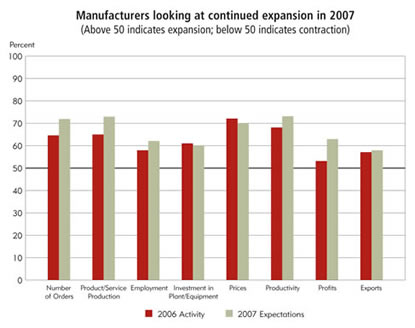This comment by a western Wisconsin manufacturer reflects the views of many of the respondents to the November survey of manufacturers by the Federal Reserve Bank of Minneapolis and the Minnesota Department of Employment and Economic Development.
Robust manufacturing activity in 2006 was reported across most of the district. Demand for manufactured products increased as new orders piled up. This led district manufacturers to increase production and prices. Also, respondents reported increased employment, capital equipment investment and productivity. Respondents from Montana and the Dakotas reported the largest increase in activity. However, respondents from the Upper Peninsula of Michigan saw decreases in orders, production and employment. The profit picture was somewhat mixed, as respondents from Montana, South Dakota and western Wisconsin reported the highest gains, while profits in the rest of the district were flat.
Optimism for 2007 grew as the number of orders is expected to increase. Over half of the respondents expect increased orders, and 12 percent see decreases. Companies plan to increase production to meet this demand by adding capital equipment and employees. Over a third of the respondents expect to add employees; only 11 percent expect to decrease employment. They anticipate having problems filling those positions, as nearly half reported a low availability of workers in their area. "Getting people, trained or untrained, is very difficult at this time," commented a respondent from Montana.

Survey respondents also expect prices and productivity to increase, contributing to expectations of higher profits—45 percent of the respondents expect increased profits next year. The strongest outlook for profit increases is in Montana and western Wisconsin. However, the slowdown in the housing sector has negatively affected the profit outlook for about a quarter of the respondents. "We are a sawmill—the housing market has a big impact on us," commented a respondent from South Dakota. Another South Dakota respondent commented that "2007 will be a tougher year than 2006."
Manufacturers expect growth in their state economies, as well as overall growth in employment and investment. However, they anticipate some difficulty finding appropriately skilled workers. Meanwhile, manufacturers expect consumer spending and corporate profits to flatten out and inflation to rise.
Ninth District Manufacturing Business Conditions Survey Methodology—November 2006Of the approximately 17,000 Ninth District manufacturers, a stratified random sample of 2,363 businesses was drawn from the population. For each state except Minnesota (see note below), the population was stratified based on employment size; the sample includes 100 percent of establishments with more than 49 employees, 20 percent with 5 to 49 employees and 3 percent fewer than 5 employees. A postcard survey was mailed to each of the selected businesses. The mailing was sent in late October/early November, and a second mailing was sent in mid November to Minnesota businesses that did not respond to the first mailing. A cutoff for survey responses was December 8. A total of 475 usable surveys was received, for a response rate of 20 percent. Of the usable surveys, 84 were from respondents indicating that their specific location had no manufacturing on site. Survey results were tabulated for all manufacturers. The confidence interval for sampling error was calculated. The 95 percent confidence interval for the table of results for all manufacturers is plus or minus 4.4 percentage points. Results are also subject to errors introduced by other factors, such as the wording of questions and differences between survey respondents and nonrespondents. Note: The Minnesota Department of Employment and Economic Development produced and processed the surveys for Minnesota manufacturers, and the Federal Reserve Bank of Minneapolis conducted the survey for manufacturers in Montana, North and South Dakota, Ninth District counties in western Wisconsin and the Upper Peninsula of Michigan. |
Manufacturing survey results [xls]
Related articles:
Agriculture slips during third quarter





